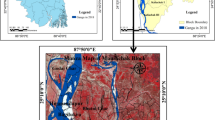Abstract
Background, Aim and Scope
Faced with higher peak discharges in the foreseeable future, the Dutch government has decided to increase the discharge capacities of the Dutch Rhine and Meuse rivers. Instead of raising the dikes, river widening measures are to be undertaken, in and along the riverbed. Such measures include surface level lowering along the rivers, channel deepening, the addition of high-discharge channels and the removal of hydraulic obstacles. To cover or reduce the costs of river widening, a coupling with aggregates (sand and/or gravel) extraction has been considered. Although the rationale of this concept is basically sound, it has met with considerable resistance, especially along the southernmost stretch of the Dutch Meuse River, in the Maaswerken project area.
Main Features: The Dutch river widening projects are quite unique in size and occurrence, and the number of publicly documented case histories available for the planning of such works is inevitably few. We review the planning and decision-making process for the Maaswerken project, which is in a more advanced stage than that of the corresponding project for the Rhine. Sediment handling and aggregates extraction are focused on, which are key issues to this case.
Analysis and Discussion In the study area, there is a conflict of interests between the extractive industry and the local communities. The industry faces a policy of phasing out mineral extraction; river widening presents the last significant prospects in the area. The general public, however, has come to resent mineral extraction because of its historical impacts. Aiming at a manageable process, the Maaswerken project management kept most stakeholders in a basically reactive position: the general public was kept informed and enabled to submit formal reactions to draft planning decisions. Aggregate extraction plans and extraction volumes were only discussed with the industry. Despite not being represented, the public influenced this negotiation process by expressing dissatisfaction with interim outcomes through the media and political channels. Plans had to be reconsidered, and this closed process turned out to be only seemingly efficient.
Conclusions: The level of public concern regarding the Maaswerken project suggests that the overall level of stakeholder involvement may have been insufficient, even though it complied with pertinent environmental and planning legislation. A participation deficit seems to have mainly occurred when defining the project's preconditions: a predefined, controversial role for the extractive industry was implicit in self-financed river widening. As planning and decision making in large projects such as the Maaswerken are prone to be affected by a negative public opinion, it is recommended that social feasibility is assessed and addressed at the very outset.
Similar content being viewed by others
Author information
Authors and Affiliations
Corresponding author
Rights and permissions
About this article
Cite this article
Meulen, M., Rijnveld, M., Gerrits, L. et al. Handling Sediments in Dutch River Management: The Planning Stage of the Maaswerken River Widening Project. J Soils Sediments 6, 163–172 (2006). https://doi.org/10.1065/jss2006.06.165
Received:
Accepted:
Published:
Issue Date:
DOI: https://doi.org/10.1065/jss2006.06.165




